Abstract
Sixteen monoclonal antibodies (MAbs) directed against toxic shock syndrome toxin-1 (TSST-1) were generated by immunization of mice with purified TSST-1 and subsequent fusion of spleen cells with myeloma cells. Antibody-producing clones, identified by an enzyme-linked immunosorbent assay, were maintained as ascites tumors, and MAbs were purified by protein A chromatography. High-titered clones were further characterized and tested for the ability to neutralize several biological activities of TSST-1. The MAbs, which are of several immunoglobulin subtypes, reacted specifically with purified TSST-1 and TSST-1 present in Staphylococcus aureus culture supernatants. Three MAbs neutralized TSST-1-induced mitogenesis in a dose-dependent manner. Three of eight MAbs tested were able to neutralize induction by TSST-1 of interleukin-1 production by human monocytes. One neutralizing MAb, 8-5-7, was tested for the ability to protect rabbits from a constant infusion of TSST-1. Rabbits given the MAb had an attenuated clinical illness and were protected from the hypocalcemia, lipemia, and hepatic and renal insufficiency seen in control rabbits. Six of seven control rabbits died, compared with only one of seven rabbits treated with MAb 8-5-7. These experiments suggest that MAb 8-5-7 is directed against an antigenic determinant critical to the toxicity of TSST-1 and that the MAbs should be useful as probes in structure-function analyses of the TSST-1 molecule.
Full text
PDF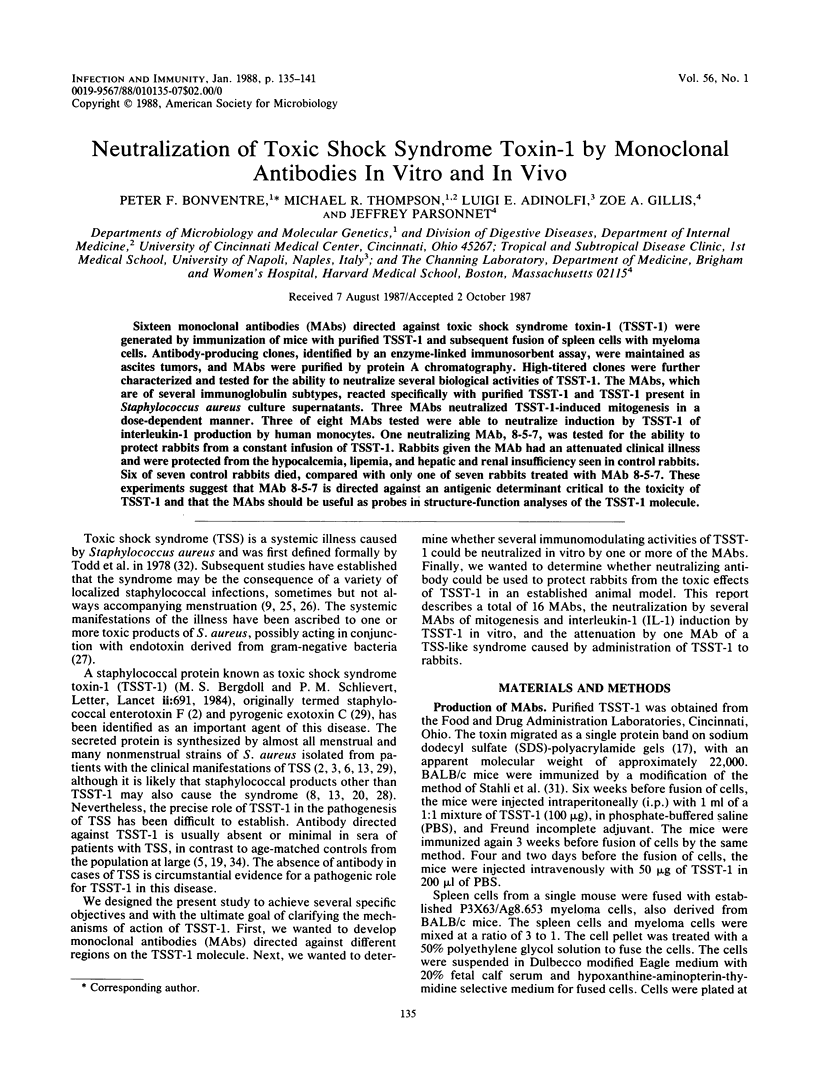
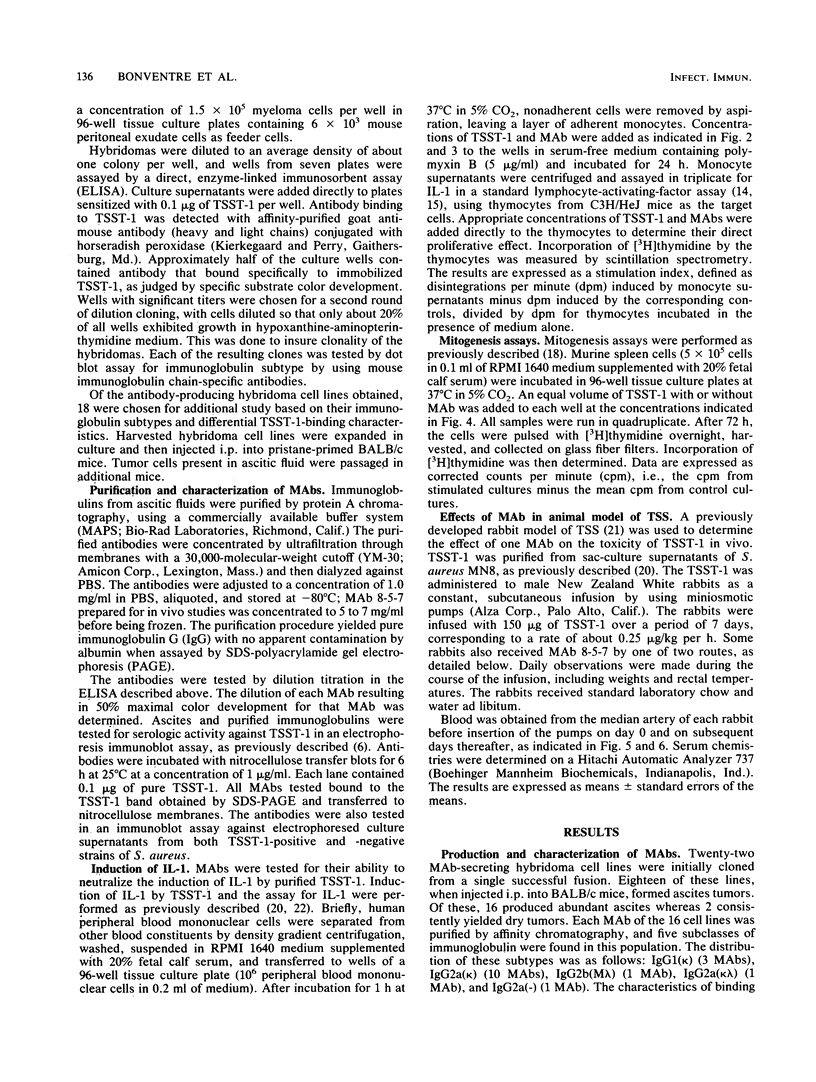
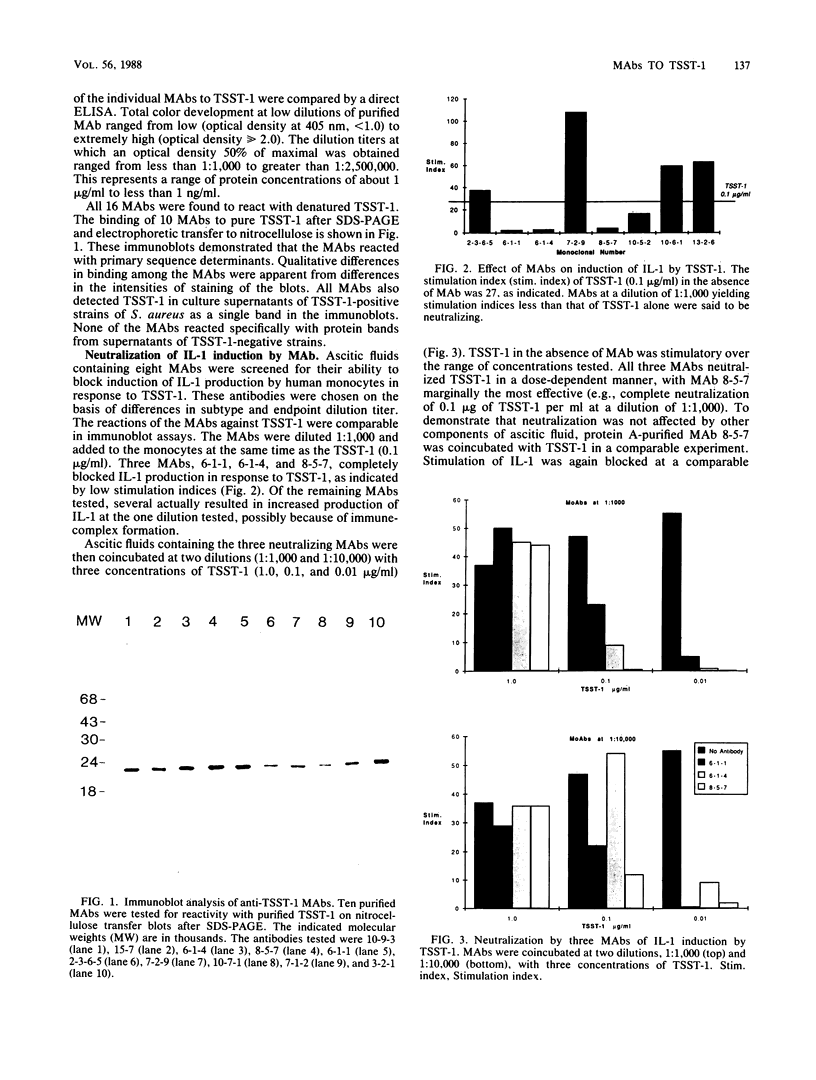
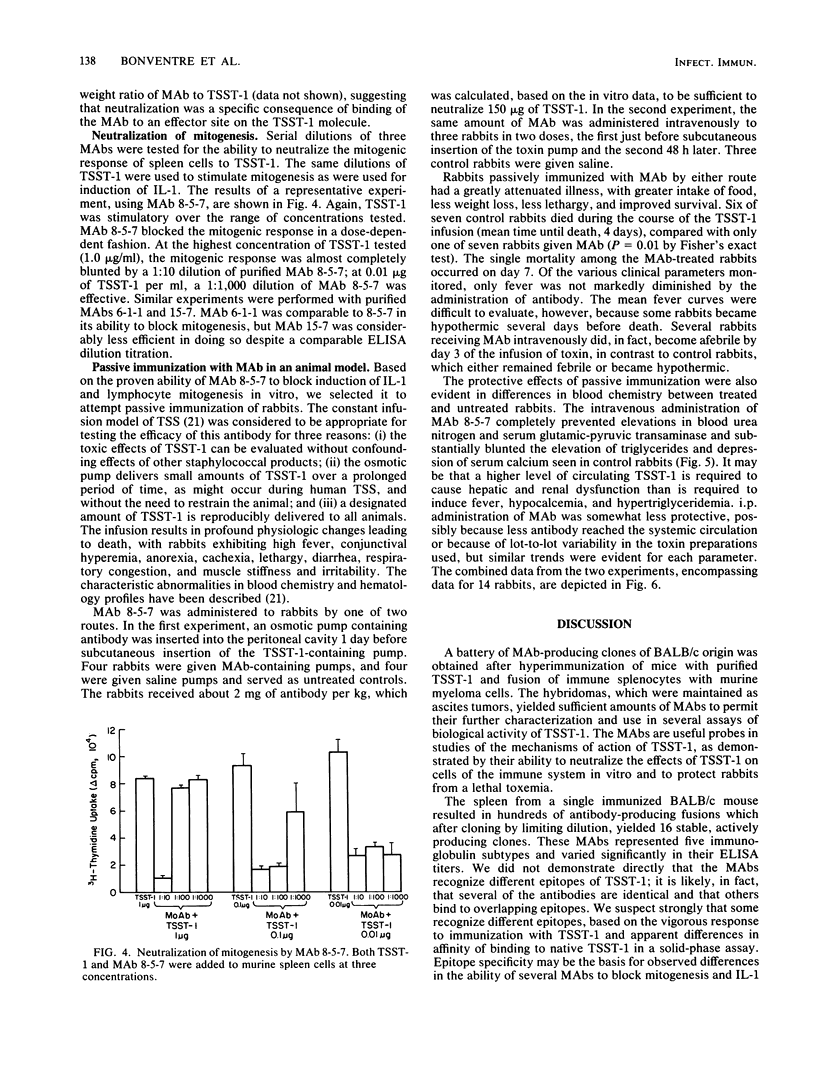
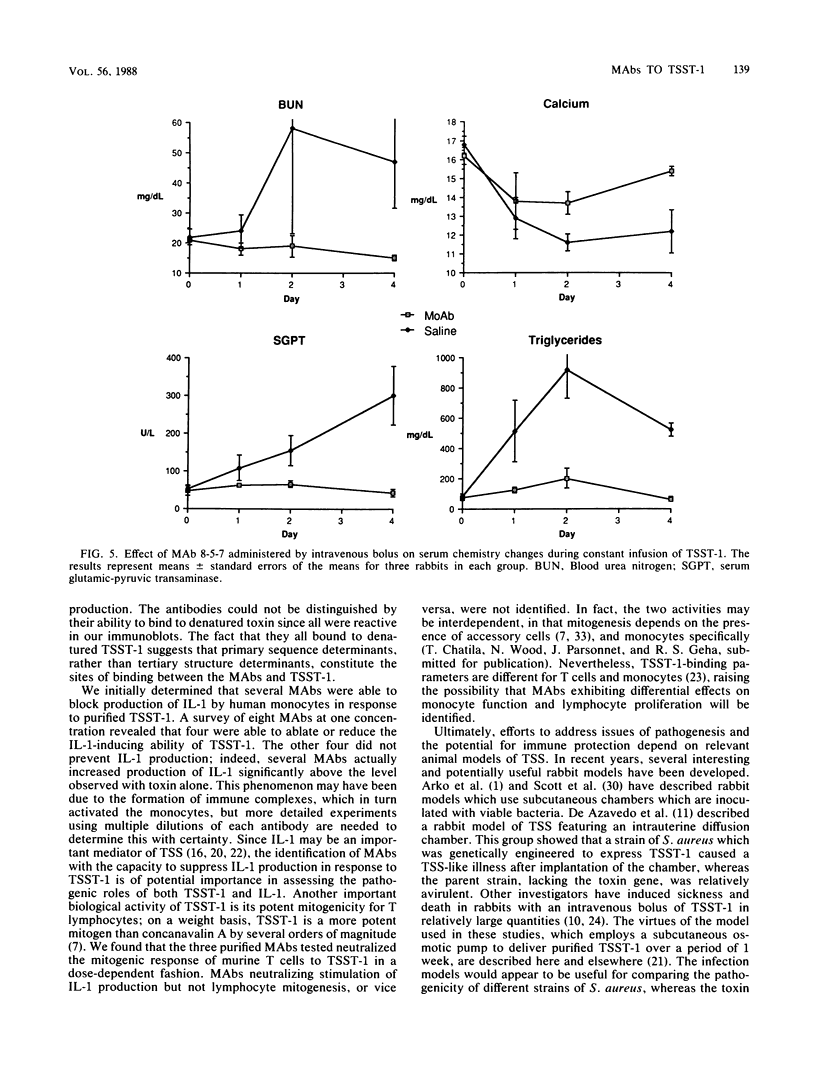
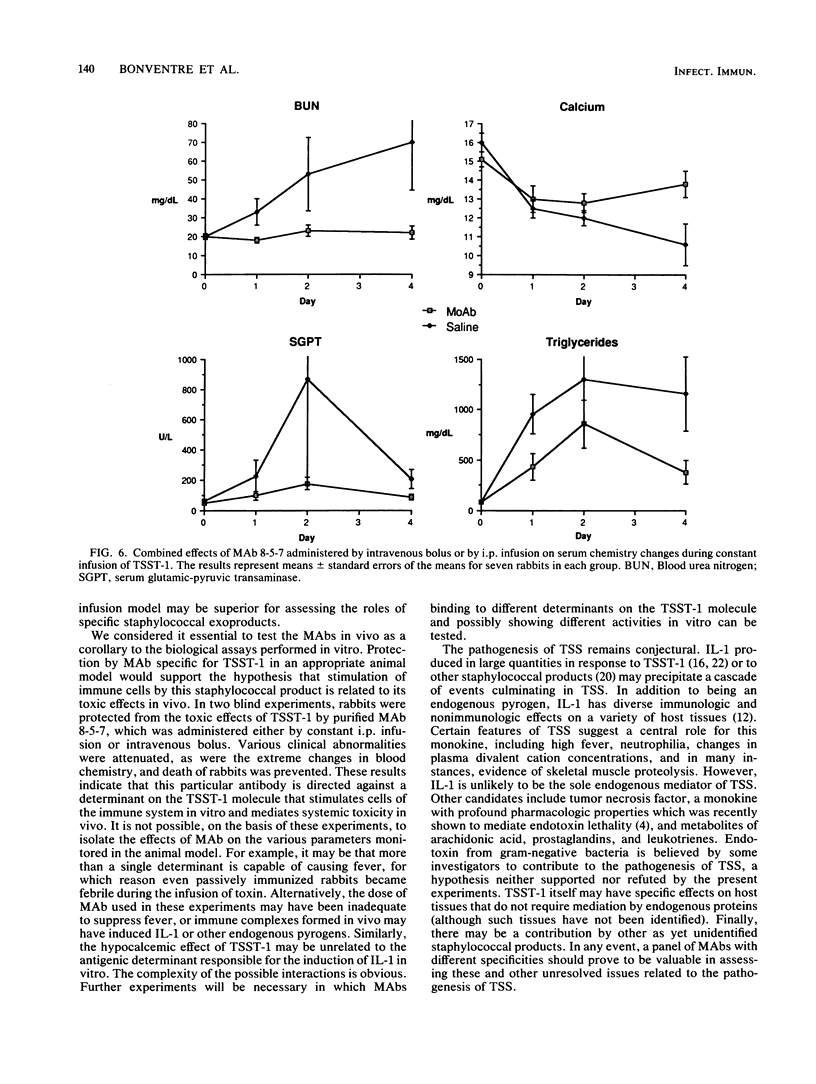
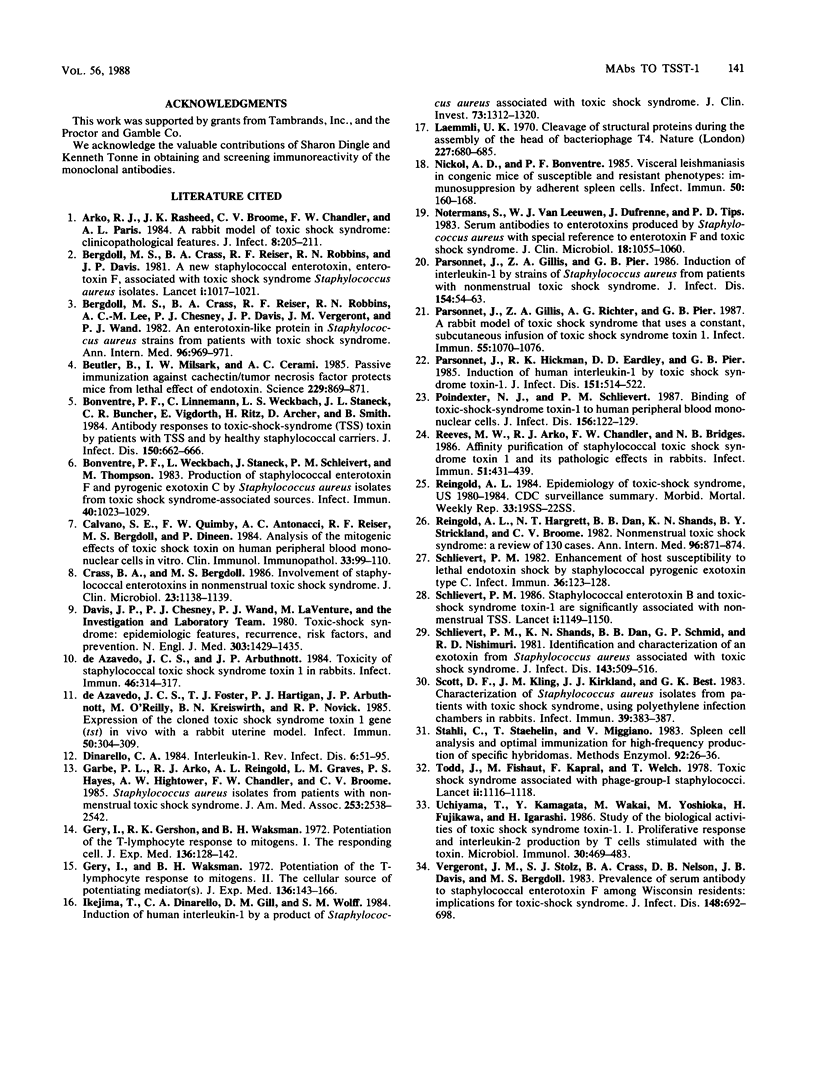
Images in this article
Selected References
These references are in PubMed. This may not be the complete list of references from this article.
- Arko R. J., Rasheed J. K., Broome C. V., Chandler F. W., Paris A. L. A rabbit model of toxic shock syndrome: clinicopathological features. J Infect. 1984 May;8(3):205–211. doi: 10.1016/s0163-4453(84)93859-3. [DOI] [PubMed] [Google Scholar]
- Bergdoll M. S., Crass B. A., Reiser R. F., Robbins R. N., Davis J. P. A new staphylococcal enterotoxin, enterotoxin F, associated with toxic-shock-syndrome Staphylococcus aureus isolates. Lancet. 1981 May 9;1(8228):1017–1021. doi: 10.1016/s0140-6736(81)92186-3. [DOI] [PubMed] [Google Scholar]
- Bergdoll M. S., Crass B. A., Reiser R. F., Robbins R. N., Lee A. C., Chesney P. J., Davis J. P., Vergeront J. M., Wand P. J. An enterotoxin-like protein in Staphylococcus aureus strains from patients with toxic shock syndrome. Ann Intern Med. 1982 Jun;96(6 Pt 2):969–971. doi: 10.7326/0003-4819-96-6-969. [DOI] [PubMed] [Google Scholar]
- Beutler B., Milsark I. W., Cerami A. C. Passive immunization against cachectin/tumor necrosis factor protects mice from lethal effect of endotoxin. Science. 1985 Aug 30;229(4716):869–871. doi: 10.1126/science.3895437. [DOI] [PubMed] [Google Scholar]
- Bonventre P. F., Linnemann C., Weckbach L. S., Staneck J. L., Buncher C. R., Vigdorth E., Ritz H., Archer D., Smith B. Antibody responses to toxic-shock-syndrome (TSS) toxin by patients with TSS and by healthy staphylococcal carriers. J Infect Dis. 1984 Nov;150(5):662–666. doi: 10.1093/infdis/150.5.662. [DOI] [PubMed] [Google Scholar]
- Bonventre P. F., Weckbach L., Staneck J., Schlievert P. M., Thompson M. Production of staphylococcal enterotoxin F and pyrogenic exotoxin C by Staphylococcus aureus isolates from toxic shock syndrome-associated sources. Infect Immun. 1983 Jun;40(3):1023–1029. doi: 10.1128/iai.40.3.1023-1029.1983. [DOI] [PMC free article] [PubMed] [Google Scholar]
- Calvano S. E., Quimby F. W., Antonacci A. C., Reiser R. F., Bergdoll M. S., Dineen P. Analysis of the mitogenic effects of toxic shock toxin on human peripheral blood mononuclear cells in vitro. Clin Immunol Immunopathol. 1984 Oct;33(1):99–110. doi: 10.1016/0090-1229(84)90296-4. [DOI] [PubMed] [Google Scholar]
- Crass B. A., Bergdoll M. S. Involvement of staphylococcal enterotoxins in nonmenstrual toxic shock syndrome. J Clin Microbiol. 1986 Jun;23(6):1138–1139. doi: 10.1128/jcm.23.6.1138-1139.1986. [DOI] [PMC free article] [PubMed] [Google Scholar]
- Davis J. P., Chesney P. J., Wand P. J., LaVenture M. Toxic-shock syndrome: epidemiologic features, recurrence, risk factors, and prevention. N Engl J Med. 1980 Dec 18;303(25):1429–1435. doi: 10.1056/NEJM198012183032501. [DOI] [PubMed] [Google Scholar]
- Dinarello C. A. Interleukin-1. Rev Infect Dis. 1984 Jan-Feb;6(1):51–95. doi: 10.1093/clinids/6.1.51. [DOI] [PubMed] [Google Scholar]
- Garbe P. L., Arko R. J., Reingold A. L., Graves L. M., Hayes P. S., Hightower A. W., Chandler F. W., Broome C. V. Staphylococcus aureus isolates from patients with nonmenstrual toxic shock syndrome. Evidence for additional toxins. JAMA. 1985 May 3;253(17):2538–2542. [PubMed] [Google Scholar]
- Gery I., Gershon R. K., Waksman B. H. Potentiation of the T-lymphocyte response to mitogens. I. The responding cell. J Exp Med. 1972 Jul 1;136(1):128–142. doi: 10.1084/jem.136.1.128. [DOI] [PMC free article] [PubMed] [Google Scholar]
- Gery I., Waksman B. H. Potentiation of the T-lymphocyte response to mitogens. II. The cellular source of potentiating mediator(s). J Exp Med. 1972 Jul 1;136(1):143–155. doi: 10.1084/jem.136.1.143. [DOI] [PMC free article] [PubMed] [Google Scholar]
- Ikejima T., Dinarello C. A., Gill D. M., Wolff S. M. Induction of human interleukin-1 by a product of Staphylococcus aureus associated with toxic shock syndrome. J Clin Invest. 1984 May;73(5):1312–1320. doi: 10.1172/JCI111334. [DOI] [PMC free article] [PubMed] [Google Scholar]
- Laemmli U. K. Cleavage of structural proteins during the assembly of the head of bacteriophage T4. Nature. 1970 Aug 15;227(5259):680–685. doi: 10.1038/227680a0. [DOI] [PubMed] [Google Scholar]
- Nickol A. D., Bonventre P. F. Visceral leishmaniasis in congenic mice of susceptible and resistant phenotypes: immunosuppression by adherent spleen cells. Infect Immun. 1985 Oct;50(1):160–168. doi: 10.1128/iai.50.1.160-168.1985. [DOI] [PMC free article] [PubMed] [Google Scholar]
- Notermans S., van Leeuwen W. J., Dufrenne J., Tips P. D. Serum antibodies to enterotoxins produced by Staphylococcus aureus with special reference to enterotoxin F and toxic shock syndrome. J Clin Microbiol. 1983 Nov;18(5):1055–1060. doi: 10.1128/jcm.18.5.1055-1060.1983. [DOI] [PMC free article] [PubMed] [Google Scholar]
- Parsonnet J., Gillis Z. A., Pier G. B. Induction of interleukin-1 by strains of Staphylococcus aureus from patients with nonmenstrual toxic shock syndrome. J Infect Dis. 1986 Jul;154(1):55–63. doi: 10.1093/infdis/154.1.55. [DOI] [PubMed] [Google Scholar]
- Parsonnet J., Gillis Z. A., Richter A. G., Pier G. B. A rabbit model of toxic shock syndrome that uses a constant, subcutaneous infusion of toxic shock syndrome toxin 1. Infect Immun. 1987 May;55(5):1070–1076. doi: 10.1128/iai.55.5.1070-1076.1987. [DOI] [PMC free article] [PubMed] [Google Scholar]
- Parsonnet J., Hickman R. K., Eardley D. D., Pier G. B. Induction of human interleukin-1 by toxic-shock-syndrome toxin-1. J Infect Dis. 1985 Mar;151(3):514–522. doi: 10.1093/infdis/151.3.514. [DOI] [PubMed] [Google Scholar]
- Poindexter N. J., Schlievert P. M. Binding of toxic-shock-syndrome toxin-1 to human peripheral blood mononuclear cells. J Infect Dis. 1987 Jul;156(1):122–129. doi: 10.1093/infdis/156.1.122. [DOI] [PubMed] [Google Scholar]
- Reeves M. W., Arko R. J., Chandler F. W., Bridges N. B. Affinity purification of staphylococcal toxic shock syndrome toxin 1 and its pathologic effects in rabbits. Infect Immun. 1986 Feb;51(2):431–439. doi: 10.1128/iai.51.2.431-439.1986. [DOI] [PMC free article] [PubMed] [Google Scholar]
- Reingold A. L. Epidemiology of toxic-shock syndrome, United States, 1960-1984. MMWR CDC Surveill Summ. 1984;33(3):19SS–22SS. [PubMed] [Google Scholar]
- Reingold A. L., Hargrett N. T., Dan B. B., Shands K. N., Strickland B. Y., Broome C. V. Nonmenstrual toxic shock syndrome: a review of 130 cases. Ann Intern Med. 1982 Jun;96(6 Pt 2):871–874. doi: 10.7326/0003-4819-96-6-871. [DOI] [PubMed] [Google Scholar]
- Schlievert P. M. Enhancement of host susceptibility to lethal endotoxin shock by staphylococcal pyrogenic exotoxin type C. Infect Immun. 1982 Apr;36(1):123–128. doi: 10.1128/iai.36.1.123-128.1982. [DOI] [PMC free article] [PubMed] [Google Scholar]
- Schlievert P. M., Shands K. N., Dan B. B., Schmid G. P., Nishimura R. D. Identification and characterization of an exotoxin from Staphylococcus aureus associated with toxic-shock syndrome. J Infect Dis. 1981 Apr;143(4):509–516. doi: 10.1093/infdis/143.4.509. [DOI] [PubMed] [Google Scholar]
- Schlievert P. M. Staphylococcal enterotoxin B and toxic-shock syndrome toxin-1 are significantly associated with non-menstrual TSS. Lancet. 1986 May 17;1(8490):1149–1150. doi: 10.1016/s0140-6736(86)91859-3. [DOI] [PubMed] [Google Scholar]
- Scott D. F., Kling J. M., Kirkland J. J., Best G. K. Characterization of Staphylococcus aureus isolates from patients with toxic shock syndrome, using polyethylene infection chambers in rabbits. Infect Immun. 1983 Jan;39(1):383–387. doi: 10.1128/iai.39.1.383-387.1983. [DOI] [PMC free article] [PubMed] [Google Scholar]
- Stähli C., Staehelin T., Miggiano V. Spleen cell analysis and optimal immunization for high-frequency production of specific hybridomas. Methods Enzymol. 1983;92:26–36. doi: 10.1016/0076-6879(83)92006-2. [DOI] [PubMed] [Google Scholar]
- Todd J., Fishaut M., Kapral F., Welch T. Toxic-shock syndrome associated with phage-group-I Staphylococci. Lancet. 1978 Nov 25;2(8100):1116–1118. doi: 10.1016/s0140-6736(78)92274-2. [DOI] [PubMed] [Google Scholar]
- Uchiyama T., Kamagata Y., Wakai M., Yoshioka M., Fujikawa H., Igarashi H. Study of the biological activities of toxic shock syndrome toxin-1. I. Proliferative response and interleukin 2 production by T cells stimulated with the toxin. Microbiol Immunol. 1986;30(5):469–483. doi: 10.1111/j.1348-0421.1986.tb02973.x. [DOI] [PubMed] [Google Scholar]
- Vergeront J. M., Stolz S. J., Crass B. A., Nelson D. B., Davis J. P., Bergdoll M. S. Prevalence of serum antibody to staphylococcal enterotoxin F among Wisconsin residents: implications for toxic-shock syndrome. J Infect Dis. 1983 Oct;148(4):692–698. doi: 10.1093/infdis/148.4.692. [DOI] [PubMed] [Google Scholar]
- de Azavedo J. C., Arbuthnott J. P. Toxicity of staphylococcal toxic shock syndrome toxin 1 in rabbits. Infect Immun. 1984 Nov;46(2):314–317. doi: 10.1128/iai.46.2.314-317.1984. [DOI] [PMC free article] [PubMed] [Google Scholar]
- de Azavedo J. C., Foster T. J., Hartigan P. J., Arbuthnott J. P., O'Reilly M., Kreiswirth B. N., Novick R. P. Expression of the cloned toxic shock syndrome toxin 1 gene (tst) in vivo with a rabbit uterine model. Infect Immun. 1985 Oct;50(1):304–309. doi: 10.1128/iai.50.1.304-309.1985. [DOI] [PMC free article] [PubMed] [Google Scholar]



